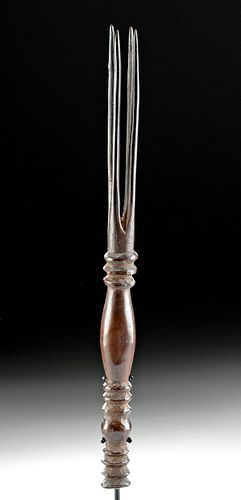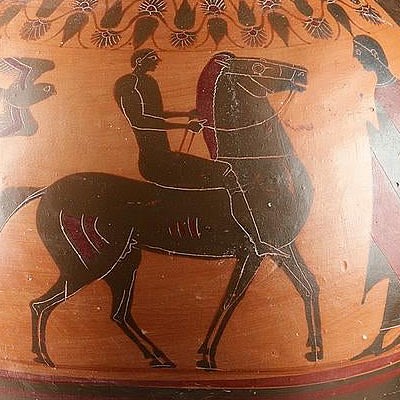19th C. Fijian Wood Cannibal Fork w/ Great Patina
Lot 162
About Seller
Artemis Fine Arts
686 S Taylor Ave, Ste 106
Louisville, CO 80027
United States
Selling antiquities, ancient and ethnographic art online since 1993, Artemis Gallery specializes in Classical Antiquities (Egyptian, Greek, Roman, Near Eastern), Asian, Pre-Columbian, African / Tribal / Oceanographic art. Our extensive inventory includes pottery, stone, metal, wood, glass and textil...Read more
Categories
Estimate:
$4,500 - $6,500
Absentee vs Live bid
Two ways to bid:
- Leave a max absentee bid and the platform will bid on your behalf up to your maximum bid during the live auction.
- Bid live during the auction and your bids will be submitted real-time to the auctioneer.
Bid Increments
| Price | Bid Increment |
|---|---|
| $0 | $25 |
| $300 | $50 |
| $1,000 | $100 |
| $2,000 | $250 |
| $5,000 | $500 |
| $10,000 | $1,000 |
| $20,000 | $2,500 |
| $50,000 | $5,000 |
| $100,000 | $10,000 |
| $200,000 | $20,000 |
About Auction
By Artemis Fine Arts
Jun 4, 2020
Set Reminder
2020-06-04 10:00:00
2020-06-04 10:00:00
America/New_York
Bidsquare
Bidsquare : Exceptional Antiquities, Asian, Ethnographic
https://www.bidsquare.com/auctions/artemis-gallery/exceptional-antiquities-asian-ethnographic-5185
An important one-day auction featuring museum-worthy examples of Egyptian, Greek, Roman, Etruscan, Near Eastern, Far East / Asian, Pre-Columbian, African / Tribal, Oceanic, Native American, Spanish Colonial, Russian, Fossils, Ancient Jewelry, Fine Art, so much more! Artemis Fine Arts info@artemisfinearts.com
An important one-day auction featuring museum-worthy examples of Egyptian, Greek, Roman, Etruscan, Near Eastern, Far East / Asian, Pre-Columbian, African / Tribal, Oceanic, Native American, Spanish Colonial, Russian, Fossils, Ancient Jewelry, Fine Art, so much more! Artemis Fine Arts info@artemisfinearts.com
- Lot Description
Oceania, Polynesia, Fiji Islands, ca. 19th century CE. A beautiful yet macabre memento from the days of tribally endorsed cannibalism, this hand-carved wooden fork was employed by servants or slaves to feed morsels of human flesh to rulers or religious leaders deemed too holy to physically handle their own food. The ovoid wooden handle is enclosed with trios of incised ringlets with a similar design for the pommel end, and a quartet of slender prongs project upwards from the shoulder. Though the prongs do not touch, their tight grouping enabled the servants to pluck only the most desirable portions for their master to consume. An intricately carved example enveloped in rich patina. Size: 1.1" W x 14.75" H (2.8 cm x 37.5 cm); 16" H (40.6 cm) on included custom stand.
The Fijian cannibal fork, known locally as an "iculanibokola," became a symbolic means of displaying one's power over those they ruled over or controlled. The more elaborate the utensil, the greater the influence one had over those around them. Despite the morbid reality of cannibalism, it was not as prevalent a practice as one would believe. Chieftains would generally only consume members of rival tribes captured in battle, and would associate doing so as a component of important post-conflict ceremonial meals and celebrations.
For a stylistically similar example with a less ornate handle, please see the University of Pennsylvania Museum of Archaeology and Anthropology, object number 18199A.
Provenance: private Hawaii, USA collection; ex-Serge Schoffel collection, Paris, France, acquired in 2014
All items legal to buy/sell under U.S. Statute covering cultural patrimony Code 2600, CHAPTER 14, and are guaranteed to be as described or your money back.
A Certificate of Authenticity will accompany all winning bids.
We ship worldwide and handle all shipping in-house for your convenience.
#154537Repairs to one full prong and tip of a second prong, with light adhesive residue along break lines. Minor abrasions, a couple of stable hairline fissures, and very light encrustations within some recessed areas. Smooth surface texture and fabulous patina throughout.Condition
- Shipping Info
-
All shipping is handled in-house for your convenience. Your invoice from Artemis Gallery will include shipping calculation instructions. If in doubt, please inquire BEFORE bidding for estimated shipping costs for individual items.
-
- Buyer's Premium



 EUR
EUR CAD
CAD AUD
AUD GBP
GBP MXN
MXN HKD
HKD CNY
CNY MYR
MYR SEK
SEK SGD
SGD CHF
CHF THB
THB














